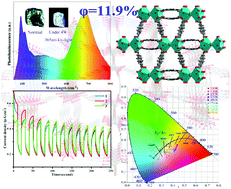Achievement of intrinsic white light emission by hybridization-deformable haloplumbates with rigid luminescent naphthalene motifs†
Abstract
The design of single-component broadband photoemitters with high stability is imperative for the development of next-generation WLEDs. In this work, 1D cationic haloplumbate chains and rigid luminescent naphthalene dicarboxylate (2,6-ndc) with a larger conjugated system were used to construct crystalline single-component broadband photoemitters, i.e. formulated as [(Pb4X2)(ndc)4·A2]n (X = Cl, Br, and I, A = (CH3)3NH+ and (CH3)2NH2+). These hybrids are 3D networks built from flexible 1D cationic (Pb4X2)6+ chains and rigid 2,6-naphthalene dicarboxylic acid ligands. The variation of halogen atoms from Cl to Br/I with higher polarity can switch the holo-directed geometry to the hemi-directed geometry with different distorted degrees. The larger conjugated system of 2,6-ndc leads to strong individual blue adsorptions and emissions. In particular, the Br- and I-analogues with hemi-directed geometries can give rise to additional red emissions, corresponding to the presence of stereochemical activities of Pb centers. Consequently, Br- and I-analogues are white-light emitters containing red emissions stemming from deformable haloplumbate and blue emissions originating from luminescent naphthalene motifs. Interestingly, haloplumbate-based emissions are thermally tunable, and those of naphthalene are generally inactive to thermal stimulus. As a result, tunable emissions from blue/white to yellow can be achieved. The higher quantum yield of Br-analogues can be assigned to their worse haloplumbate connectivity, which can enhance the electron–phonon coupling. In all, the combination of flexible haloplumbate chains with larger π-conjugated fluorophores is an efficient strategy for the construction of tunable broadband photoemitters.



 Please wait while we load your content...
Please wait while we load your content...